Delta wing

.png)
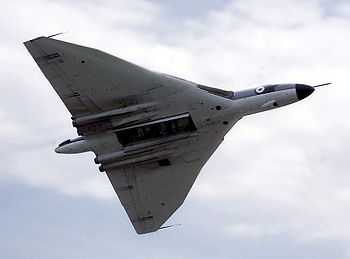
The delta wing is a wing planform in the form of a triangle. It is named for its similarity in shape to the Greek uppercase letter delta (Δ).
History
Delta-shaped stabilizers
Between 1529 and 1556 Conrad Haas wrote a book in which he described rocket technology, involving the combination of fireworks and weapons technologies. This manuscript was re-discovered in 1961, in the Sibiu public records (Sibiu public records Varia II 374). His work dealt with the theory of motion of multistage rockets, different fuel mixtures using liquid fuel, and also introduced delta-shaped stabilizers.[1] The conception of such stabilizers and their name had been suggested in the 17th century by the Polish-Lithuanian military engineer Kazimierz Siemienowicz.[2][3][4]
Delta wing
The first practical uses of delta wing came in the form of the so-called "tailless delta", i.e. without the horizontal tailplane. In fact, the designs were at the same time also the first flying wings. It could be argued that the 1924 Cheranovsky designs, having a one-of-a-kind parabolic planform,[5] fit the category of delta wings. Nevertheless, a triangular wing was pioneered especially by Alexander Lippisch in Germany. He was the first to fly a tailless delta aircraft in 1931,[6][7] followed by four improved designs. None of these was easy to handle at slow speeds, and none saw widespread service.[8][9] During the war Lippisch studied a number of ramjet powered delta-wing interceptor aircraft, one progressing as far as a glider prototype.[10] Another pioneering design was the 1934 delta-wing Sigma 4 Interceptor, designed by Aleksandr Moskalyev in the Soviet Union.
Most significantly Robert T. Jones, working at NACA during World War II, developed a theory for delta wings. First published in January of 1945, this approach differed from earlier attempts at delta wings as Jones combined a delta planform with a thin airfoil. This design proved to be superior to the thick winged deltas done by Lippisch, and would form the basis of post-World War II delta winged aircraft such as those made by Convair.[11][12]
The tailless delta became a favored design for high-speed use, and was used almost to the exclusion of other designs by Convair and by Dassault Aviation in France, notably with the popular Dassault Mirage III. Convair's F-102 Delta Dagger was the first fighter with a tailless delta wing in service with any air force anywhere in the world.
Meanwhile, the British also developed aircraft based on the data from Lippisch, notably the Avro Vulcan strategic bomber and the Gloster Javelin fighter. The Javelin incorporated a tailplane in order to rectify some of the perceived weaknesses of the pure delta, to improve low-speed handling and high-speed manoeuvrability and to allow a greater center of gravity range.[13]
The tailed delta configuration was again adopted by the TsAGI (Central Aero and Hydrodynamic Institute, Moscow), to take advantage of both high angle-of-attack flying capability and high speeds. It was used in the MiG-21 ("Fishbed") and Sukhoi Su-9/Su-11/15 fighters, built by the tens of thousands in several different communist countries.
Saab AB used a close-coupled damped canard foreplane[14] in front of the main wing of the Viggen fighter. The close coupling actively modifies the airflow over the wing, most notably during flight at high angles of attack. In contrast to the classic tail-mounted elevators, the canards add to the total lift, enabling the execution of extreme maneuvers, improving low-speed handling and lowering the landing speed.
Properties
The primary advantage of the delta wing is that, with a large enough angle of rearward sweep, the wing’s leading edge will not contact the shock wave boundary formed at the nose of the fuselage as the speed of the aircraft approaches and exceeds transonic to supersonic speed. The rearward sweep angle vastly lowers the airspeed normal to the leading edge of the wing, thereby allowing the aircraft to fly at high subsonic, transonic, or supersonic speed, while the over wing speed of the lifting air is kept to less than the speed of sound. The delta planform gives the largest total wing area (generating useful lift) for the wing shape, with very low wing per-unit loading, permitting high manoeuvrability in the airframe. As the delta's platform carries across the entire aircraft, it can be built much more strongly than a swept wing, where the spar meets the fuselage far in front of the center of gravity. Generally a delta will be stronger than a similar swept wing, as well as having much more internal volume for fuel and other storage.

Another advantage is that as the angle of attack increases, the leading edge of the wing generates a vortex which energizes the flow, giving the delta a very high stall angle. A normal wing built for high speed use is typically dangerous at low speeds, but in this regime the delta changes over to a mode of lift based on the vortex it generates. Additional advantages of the delta wing are simplicity of manufacture, strength, and substantial interior volume for fuel or other equipment. Because the delta wing is simple, it can be made very robust (even if it is quite thin), and it is easy and relatively inexpensive to build – a substantial factor in the success of the MiG-21 and Mirage aircraft.
The disadvantages, especially marked in the older tailless delta designs, are a loss of total available lift caused by turning up the wing trailing edge or the control surfaces (as required to achieve a sufficient stability) and the high induced drag of this low-aspect ratio type of wing. This causes delta-winged aircraft to 'bleed off' energy very rapidly in turns, a disadvantage in aerial manoeuvre combat and dogfighting. It also causes a reduction in lift at takeoff and landing until the correct angle of attack is achieved, this means that the rear undercarriage must be more strongly built than with a conventional wing.
A canard-delta suffers from a smaller shift in the center of lift with increasing Mach number than a wing and tail configuration, but the canard is unsuitable to provide an aileron input. The canard configuration also allows a save recovery from a high angle of attack with an unload or free floating canard. This changes a static longitudinal unstable configuration to a static longitudinal stable configuration.[15][16]
When used with a T-tail as in the Gloster Javelin the large delta wing could give rise to a "deep stall"; at high angles of attack the wing nullified airflow over the tail and makes the aircraft uncontrollable.[17]
Delta-wing variations
Pure delta-wings fell out of favour somewhat due to their undesirable characteristics, notably flow separation at high angles of attack (swept wings have similar problems), and high drag at low altitudes. This limited them primarily to high-speed, high-altitude interceptor roles.
Many modern fighter aircraft, such as the JAS 39 Gripen, the Eurofighter Typhoon and the Dassault Rafale use a combination of canards and a delta wing.
Tailed delta – adds a conventional tailplane (with horizontal tail surfaces), to improve handling. Common on Soviet types such as the Mikoyan-Gurevich MiG-21.
Cropped delta – tip is cut off. This helps avoid tip drag at high angles of attack. Used for example in F-16 (a cropped, tailed delta) and all three Eurocanards (cropped, tailless delta combined with a canard).
In another variant known variously as compound delta, double delta or cranked arrow, the inner part of the wing has a very high sweepback, while the outer part has less sweepback, to create the high-lift vortex in a more controlled fashion, reduce the drag and thereby allow for landing the delta at acceptably slow speed. This design can be seen on the Saab Draken fighter, the prototype F-16XL "Cranked Arrow" and in the High Speed Civil Transport study. The ogee delta (or ogival delta) used on the Anglo-French Concorde Mach 2 airliner is similar, but with a smooth 'ogee' curve joining the two parts rather than an angle.
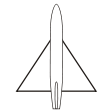 Tailless delta |
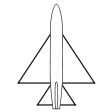 Tailed delta |
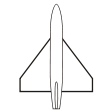 Cropped delta |
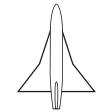 Compound delta |
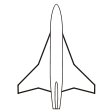 Cranked arrow |
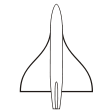 Ogival delta |
As the performance of jet engines grew, fighters with other planforms could perform as well as deltas, and do so while maneuvering much harder and at a wider range of altitudes. Today a remnant of the compound delta can be found on most fighter aircraft, in the form of leading edge extensions. These are effectively very small delta wings placed so they remain parallel to the airflow in cruising flight, but start to generate a vortex at high angles of attack. The vortex is then captured on the top of the wing to provide additional lift, thereby combining the delta's high-alpha performance with a conventional highly efficient wing planform.
Aircraft examples
Production examples
- Atlas Cheetah
- Avro Vulcan – strategic bomber
- Buran Space Shuttle
- Chengdu J-7 – a Chinese development of MiG-21
- Chengdu J-10
- Concorde
- Convair B-58 Hustler
- Convair F-102 Delta Dagger
- Convair F-106 Delta Dart
- Dassault Mirage III
- Dassault Mirage IV
- Dassault Mirage 2000
- Dassault Rafale
- Eurofighter Typhoon
- Gloster Javelin – subsonic fighter
- HAL Tejas
- IAI Kfir
- Lockheed SR-71 Blackbird
- McDonnell Douglas A-4 Skyhawk – a "tailed" delta wing aircraft
- Mikoyan-Gurevich MiG-21 – a "tailed" delta wing fighter
- Saab 35 Draken
- Saab 37 Viggen
- Saab JAS 39 Gripen
- Shenyang J-8
- Space Shuttle Orbiter
- Sukhoi Su-9
- Sukhoi Su-11
- Sukhoi Su-15 – early models
- Tupolev Tu-144
Research or prototype-only examples
- Avro 707 (1949)
- Avro Canada CF-105 Arrow - interceptor aircraft, cancelled 1959
- Boeing X-32
- Boulton Paul P.111 (1949) – research to investigate tailess deltas
- Boulton Paul P.120 (1952) – developed from P.111
- Chengdu J-9
- Chengdu J-20
- Convair F2Y Sea Dart – seaplane fighter
- Convair XF-92 (1948) - interceptor design
- Convair XFY Pogo – experimental VTOL aircraft,one of the few propeller-driven delta wing aircraft
- Dyke Delta – another of the few propeller-driven double delta wing aircraft
- Fairey Delta 1 (1951) – transonic delta research
- Fairey Delta 2 (1954) – 1st aircraft to break 1,000 mph, rebuilt as BAC 211 for high speed delta research for Concorde
- General Dynamics F-16XL - Experimental aircraft that lost to the F-15E for the USAF's Enhanced Tactical Fighter competition
- Handley Page HP.115 – low-speed delta research for Concorde
- Helwan HA-300 - interceptor aircraft, cancelled 1969
- Lavochkin La-250 - interceptor
- Myasishchev M-50
- North American XB-70 Valkyrie - Mach 3 strategic bomber project
- Short SC.1 – first British VTOL aircraft
- Sukhoi T-4 / 100 Sotka - Mach 3 strategic bomber
Notes
- ↑ "Corad Haas Raketenpionier in Siebenbürgen" [Corad Haas rocket pioneer in Transylvania]. Beruehmte Siebenbuerger Sachsen (in German). Siebenbürgen und die Siebenbürger Sachsen im Internet.
- ↑ Sieme (biography), Poland: Uranos.
- ↑ New Rocket Guide (PDF), NASA.
- ↑ Orłowski, Bolesław (Jul 1973), Technology and Culture 14 (3), JStor, pp. 461–73.
- ↑ Savine, Alexandre. "Boris Ivanovich Cheranovskij". Retrieved 12 February 2011.
- ↑ Ford, Roger (2000). Germany's secret weapons in World War II (1st ed.). Osceola, WI: MBI Publishing. p. 36. ISBN 0-7603-0847-0.
- ↑ "New Triangle Plane Is Tailless", Popular Science, December 1931: 65.
- ↑ Madelung, Ernst Heinrich; Hirschel, Horst; Prem, Gero (2004). Aeronautical research in Germany: from Lilienthal until today (American ed.). Berlin: Springer. ISBN 3-540-40645-X.
- ↑ Wohlfahrt, Karl; Nickel, Michael (1990). Schwanzlose flugzeuge : ihre auslegung und ihre eigenschaften [Tailless aircraft: their design & properties] (in German). Basel: Birkhauser. pp. 577–78. ISBN 3-7643-2502-X. Retrieved 13 February 2011.
[Lippisch Delta I and Horten H I] Both these aircraft shown, how not to do it.
- ↑ Grommo (17 May 2008), Lippisch P13a Supersonic Ramjet Fighter footage (VIDEO), Youtube.
- ↑ Von Karman, Aerodynamics: Selected Topics in the Light of their Historical Development, 1954
- ↑ Richard Hallion, Lippisch, Gluhareff and Jones: The Emergence of the Delta Planform, Aerospace Historian, March 1979.
- ↑ Partridge, J (1967), Number 179 – The Gloster Javelin 1-6, Profile.
- ↑ Green, W; Swanborough, G (1994), The complete book of fighters, Salamander .
- ↑ Probert, B, Aspects of Wing Design for Transonic and Supersonic Combat (PDF), NATO.
- ↑ Aerodynamic highlights of a fourth generation delta canard fighter aircraft, Mach flyg.
- ↑ Gloster Javelin History, UK: Thunder & Lightnings, 4 April 2012.
References
- Guan, Jingling; Sritharan, S. S (2008). "A Problem of Hyperbolic-Elliptic Type Conservation Laws on Manifolds that Arises in Delta-Wing Aerodynamics http://www.nps.edu/Academics/Schools/GSEAS/SRI/R38.pdf". International Journal of Contemporary Mathematical Sciences 3: 721–37.
- Sritharan, S. S; Seebass, AR (1984). "A Finite Area Method for Nonlinear Supersonic Conical Flows". AIAA Journal 22: 226–33. Bibcode:1984AIAAJ..22..226S. doi:10.2514/3.8372.
- Sritharan, S. S (1985). "Delta Wings with Shock-Free Cross Flow http://www.nps.edu/Academics/Schools/GSEAS/SRI/R2.pdf". Quarterly of Applied Mathematics. XLIII: 275–86.
- "Computational simulation of supersonic delta wings", Uw acad Web (MICROSOFT POWERPOINT) (presentation slides), Uwyo.
- Sritharan, S. S (1982), Nonlinear Aerodynamics of Supersonic Conical Delta wings http://arizona.openrepository.com/arizona/bitstream/10150/184669/1/azu_td_8227370_sip1_m.pdf'' (Ph.D. Dissertation, University of Arizona, Applied Mathematics Program)
External links
| Wikimedia Commons has media related to Delta wings. |